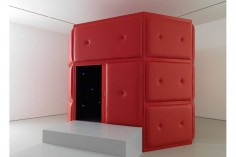TATSUO MIYAJIMA
宫岛达男
Life Palace
source: cilwoodwordpress
L’artiste contemporain japonais Tatsuo Miyajima présente un projet intitulé “Ashes to Ashes, Dust to Dust”, au UCCA (Ullens Center for Contempory Art), à Beiking.
Il utilise des compteurs à DEL, ordinateurs, circuits électriques et des vidéos de projection pour faire défiler des chiffres de un à neuf.
Ces installations laissent transparaître des idées de la philosophie bouddhiste (continuer à changer, être en connection avec le Monde) symbolisant un vaste royaume de possibilités existentielles, la nature éternelle de l’espace et du temps, et le cycle infini de la vie, mort et renaissance.
.
.
.
.
.
.
source: contemporaryartdaily
Since 1987, Tatsuo Miyajima has been constructing installations using LED digital counting devices. His works combine a performative aspect with architectonic structures, sometimes taking the shape of geometric patterns or organic shapes as well as encompassing vertical and horizontal surfaces. The LED devices count progressively from 1 to 9 or backwards – Miyajima never employs 0 – establishing a rhythm as definitive as repetition itself and the inexorable passing of time. Sometimes the colored numerals run at different speed, synching to the rhythm of natural events or the pulsing of life in individual subjectivities.
The series Counter Fragile Lifestructurism is a reflection on the becoming of life. Each human being is constituted by over 60 billion cells, testifying at every moment the miracle of living. Each LED panel, with its individual flashing element counting in reverse from the digit 9 to 1, represents one cell. As the numbers progressively count down and start anew, they renew each time the cycle of death and life.
Tatsuo Miyajima identifies the brain as the centre of life, the element that identifies a human being. The clusters Counter Fragile Counter Brain represent the network of cells where synapse activity takes place, in the transmission of a pulse.
The Pile Up Life series was originally conceived for Prospect. 1 New Orleans and is presented here for the first time in Europe. Observing how large scale natural disasters affect human beings and the sense of powerlessness that we share on these occasions, Miyajima created the work Pile Up Life as a requiem for the lives lost in these disasters. This series of towers is made of natural stones with embedded LED lights called ‘counter gadget’. The works reference traditional commemorative monuments, found in different cultures from Eastern Asia to Canada and America as well as the concept of eternal life celebrated in Buddhism. The ‘counter gadget’ are made in two colors, red and blue, each programmed to count up from 1 to 9 and down from 9 to 1. Their speed is determined by the people who pray for requiem, and translates subjective individuality into rhythm. About the artist Tatsuo Miyajima (b. 1957, Tokyo, Japan) lives and works in Ibaraki, Japan.
.
.
.
.
.
.
.
source: uccaorgcn
在日本当代先锋艺术家宫岛达男眼中,数字是抽象的,又是有具象意义的,它们象征着巨大的可能性,时间和空间的永恒,生命、死亡和重生的无限循环。他围绕着 ——“持续变化”、“关联一切”、“永无止尽”为主题进行艺术创作,这些源自古老的东方佛教哲学的概念,结合他运用的LED、计算机集成电路和视频投影技 术后,散发出充满现代感的全新魅力。
宫岛达男的很多作品中都采用了精密的LED设计,使从9到1(或从1到9)的数字——人类最为通用和极简的语言,循环跳转。当他们同时熄灭,整个房间会浸 入一片黑暗,但是在他的作品中却从未出现数字0,因为艺术家认为0意味着否定,否定了人类存在的无限循环,艺术家以让0缺失的方式引发更多对于虚无的思 考。
艺术家自述
从1988 年起,我就开始尝试用LED 和数字化的计算排列方式来进行艺术创作。其中,我想要表达的主旨有三个:“持续变化”,“关联一切”,“永无止尽”。作品的数字排列是从9 到1(或从1 到9),变化的速度因不同数字而异。0 则不被表现出来,用灯光的熄灭来代替。数字运行时所发出的光代表了“生”,而表示0 的黑暗部分则意味着“死”。我把这个计算和排列系统视为生命的象征,这是多年来我一直想表达的观念。这种思想最早源于佛教。中国为佛教的传播做了很大贡 献,因此这次来到中国举办个展,我感到很荣幸。


